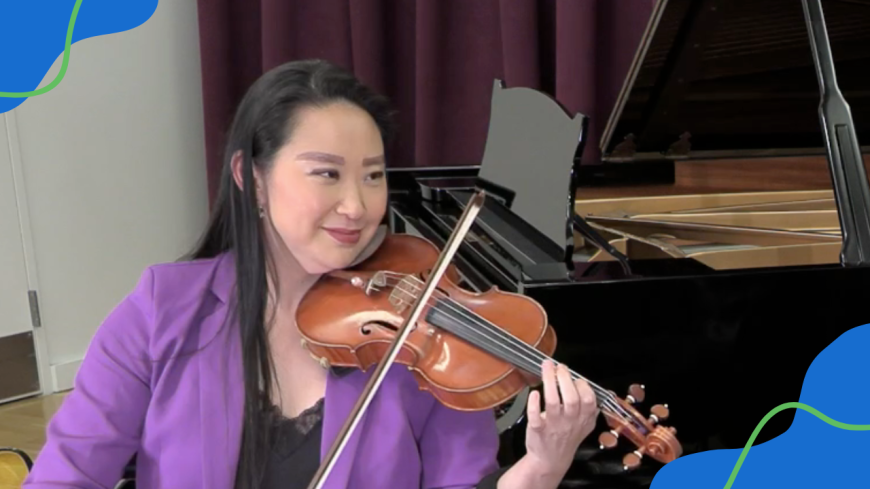Meet the Violin with MET Orchestra Violinist Katherine Fong

Earlier this year, Grammy award winning music educator and Lessonface Teacher Melissa Salguero sat down with MET Orchestra violinist Katherine Fong for a fun and lively introduction to the violin. The talk was filmed at a concert venue in New York City and was sponsored by Southwest Strings. The full video appears below this article.
Katherine brought the very first small violin she had played as a child, as well as the intermediate-size violin she later used, and her current full-size violin. Melissa asked some of the most common questions and made some keen observations, and with Katherine’s expert guidance we learned how children and adults alike can get started as beginner violinists. And we got to see Melissa take her very first violin lesson!
How do I find the notes on the violin?
Unlike a guitar, the violin has no frets or any clear visual or tactile clues for the beginner. The most common solution? Little strips of colored tape to mark the position where the fingers should be placed. As the beginner progresses, they become sensitive to the feel of the instrument and the sound of the correct pitches, and one-by-one the little strips of tape are removed (we saw less tape on Katherine’s intermediate violin).
What is the right size violin for me?
Katherine showed us how the teacher can help the student easily establish the basic violin hold with a natural and tension-free posture. From there, the student can extend their arm in the direction of the “scroll” of the violin farthest away from the body. If the wrist joint can reach past the end of the scroll, the student is ready for the next size up!
A full-size violin is also referred to as 4/4 size, and is just right for most teenagers and adults. Violins come in fractional sizes such as 3/4, 1/2, 1/4, 1/8, 1/16, and sometimes even smaller. When an in-person visit to a violin shop is not practical, reputable online violin shops can advise via phone or video, and sometimes send a selection of sizes for the student to try.
How do I learn a song on the violin?
No matter the size of the violin, they are all tuned to the same pitches. Katherine showed us how she started as a child learning some basic bow strokes on an open string, using playful spoken rhythms like “ta-ka-ta-ka Stop Stop!” (Her current favorite is “I-like-mat-cha Latt–es!”) Adding another open string, and then stopping the string with the fingers using the strips of tape as a guide, the student is soon playing a fun rhythmic variation of the well-known song “Twinkle Twinkle Little Star.”
How does the bow produce sound?
“The bow is as important as the violin” Katherine says, likening the bow to the vocal cords of the violin. Traditionally the bow is made of wood, and strung with horsehair. The hair grips the string with the help of rosin, a sticky substance made from tree sap and formed into a small dry “cake” that is rubbed onto the hair of the bow by the violinist.
How do I choose a violin bow?
A fine wood bow is the top choice for professional violinists playing classical music. These days there are good-quality inexpensive bows for students made from carbon fiber or other composite materials instead of wood, sometimes using synthetic hair. These types of bows are far less fragile than wood bows, and can be an excellent choice for beginners. It’s worth noting that some professionals use a carbon fiber bow in certain circumstances, and for certain genres, they are often preferred over wood bows. Your teacher can advise what’s best for you.
How do I learn to hold the violin bow?
Holding and controlling the bow in order to make a good sound is an art and a science, and literally a balancing act. Katherine shows us how the fingers should be placed on the bow, suggesting that the student first start with a pencil in the hand to get a feel for the natural hold. Switching from a pencil to the much longer bow requires more attention to the supporting muscles of the fingers in order to achieve a good balance in the hand.
What is a shoulder rest? Do I need one?
Melissa noticed something attached to the back of Katherine’s violin. Katherine explained the function of a “shoulder rest” for the violin, which helps the violinist hold the instrument more easily. Shoulder rests come in many shapes and sizes, but as Katherine noted, one can simply use a sponge or a piece of foam fastened to the violin with a rubber band. Since everyone’s body is different, Katherine’s advice to simply “make it comfortable” leaves plenty of room for customization and individualized solutions. Some violinists use no shoulder rest or extra padding at all, and most teachers agree that whatever is most comfortable for the individual student is the right solution.
Where can I buy a good violin?
Katherine points out that while there are some very inexpensive violin outfits (case and bow included) for sale on the big e-commerce sites that sell just about everything, it’s best to buy from a reputable shop (online or in person) that specializes exclusively in string instruments. These types of shops have expert musicians and instrument makers on staff who provide extra layers of quality control and customer service.
Do I need private lessons? How can I find the right teacher for me?
Katherine explains that it’s especially important for a beginner to start with a good teacher so that they learn the basics properly, and avoid learning poor habits that might later hinder their progress. “Lessonface for example,” Katherine says, noting the number and variety of great teachers one can choose from — “I wish I had that when I was growing up!”
Lesson Time!
What better way to sum up such a wonderful talk between these two excellent teachers than a quick beginner violin lesson. Melissa bravely picked up the 1/4 size violin (not the right size for most adults) and followed Katherine’s instructions, playing an excellent rendition of the first line of “Twinkle Twinkle Little Star.”
Delighted with the outcome — “I did not expect to be able to play the violin after this, but I think you and I should go on tour” — Melissa said to Katherine. “Yes, I think a world tour is in order,” Katherine agreed.
Find your ideal violin teacher at Lessonface.com/LearnViolin




